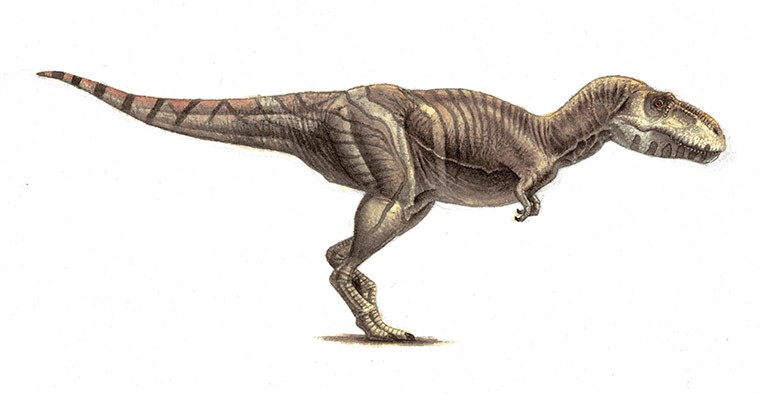Post by dinosauria101 on May 30, 2019 9:24:51 GMT 5
Tarbosaurus bataar
Tarbosaurus belongs in the subfamily Tyrannosaurinae within the family Tyrannosauridae, along with the earlier Daspletosaurus, the more recent Tyrannosaurus and possibly Alioramus. Animals in this subfamily are more closely related to Tyrannosaurus than to Albertosaurus and are known for their robust build with proportionally larger skulls and longer femurs than in the other subfamily, the Albertosaurinae. Although many specimens of this genus have been found, little definite data was confirmed on the dinosaur as of 1986, though it was presumed to share many characteristics with other tyrannosaurids. The close similarities have prompted some scientists to suggest a possible link between the North American and Eurasian continents at that time, perhaps in the form of a land bridge.As with most dinosaurs, Tarbosaurus size estimates have varied through recent years. It could have been 10 to 12 meters long, with a weight of 5-7 tonnes.

Zhuchengtyrannus magnus
Zhuchengtyrannus (meaning "Zhucheng tyrant") is a genus of tyrannosaurid theropod dinosaur known from the Late Cretaceous period of Shandong Province, China. It belongs to the tyrannosaurinae subfamily, and contains a single species, Zhuchengtyrannus magnus. Zhuchengtyrannus was first described and named by David W. E. Hone, Kebai Wang, Corwin Sullivan, Xijin Zhao, Shuqing Chen, Dunjin Li, Shuan Ji, Qiang Ji and Xing Xu in 2011 and the type species is Zhuchengtyrannus magnus. The generic name is derived from the word Zhucheng, which refers to the type locality, and tyrant in reference to its phylogenetic position as a tyrannosaurid. The specific name magnus meaning "great" in Latin refers to the relatively large size of Zhuchengtyrannus.[1]
Zhuchengtyrannus is known solely from the holotype ZCDM V0031, a nearly complete right maxilla and associated left dentary (lower jaw, both with teeth) housed at Zhucheng Dinosaur Museum. Casts of the holotype, IVPP FV 1794, are held at the Institute of Vertebrate Paleontology and Paleoanthropology. ZCDM V0031 was collected in situ from the Wangshi Group at Zangjiazhuang quarry, Zhucheng City, dating to the Campanian stage, at least 73.5 million years ago. A second tyrannosaurid dentary (ZCDM V0030) and maxilla (ZCDM V0032) have also been collected at Zangjiazhuang quarry. Even though they were not associated with one another, both specimens are different from other tyrannosaurids, including Zhuchengtyrannus, implying the existence of at least one additional tyrannosaurid from the quarry. Apart from the tyrannosaurid material, specimens of Sinoceratops, hadrosaurids (probably Shantungosaurus) and ankylosaurs were recovered from it.[1] Zhuchengtyrannus was found in an area that was a floodplain in the Cretaceous period and contains one of the highest concentrations of dinosaur bones in the world.[2]

Credit to Wikipedia
Tarbosaurus belongs in the subfamily Tyrannosaurinae within the family Tyrannosauridae, along with the earlier Daspletosaurus, the more recent Tyrannosaurus and possibly Alioramus. Animals in this subfamily are more closely related to Tyrannosaurus than to Albertosaurus and are known for their robust build with proportionally larger skulls and longer femurs than in the other subfamily, the Albertosaurinae. Although many specimens of this genus have been found, little definite data was confirmed on the dinosaur as of 1986, though it was presumed to share many characteristics with other tyrannosaurids. The close similarities have prompted some scientists to suggest a possible link between the North American and Eurasian continents at that time, perhaps in the form of a land bridge.As with most dinosaurs, Tarbosaurus size estimates have varied through recent years. It could have been 10 to 12 meters long, with a weight of 5-7 tonnes.

Zhuchengtyrannus magnus
Zhuchengtyrannus (meaning "Zhucheng tyrant") is a genus of tyrannosaurid theropod dinosaur known from the Late Cretaceous period of Shandong Province, China. It belongs to the tyrannosaurinae subfamily, and contains a single species, Zhuchengtyrannus magnus. Zhuchengtyrannus was first described and named by David W. E. Hone, Kebai Wang, Corwin Sullivan, Xijin Zhao, Shuqing Chen, Dunjin Li, Shuan Ji, Qiang Ji and Xing Xu in 2011 and the type species is Zhuchengtyrannus magnus. The generic name is derived from the word Zhucheng, which refers to the type locality, and tyrant in reference to its phylogenetic position as a tyrannosaurid. The specific name magnus meaning "great" in Latin refers to the relatively large size of Zhuchengtyrannus.[1]
Zhuchengtyrannus is known solely from the holotype ZCDM V0031, a nearly complete right maxilla and associated left dentary (lower jaw, both with teeth) housed at Zhucheng Dinosaur Museum. Casts of the holotype, IVPP FV 1794, are held at the Institute of Vertebrate Paleontology and Paleoanthropology. ZCDM V0031 was collected in situ from the Wangshi Group at Zangjiazhuang quarry, Zhucheng City, dating to the Campanian stage, at least 73.5 million years ago. A second tyrannosaurid dentary (ZCDM V0030) and maxilla (ZCDM V0032) have also been collected at Zangjiazhuang quarry. Even though they were not associated with one another, both specimens are different from other tyrannosaurids, including Zhuchengtyrannus, implying the existence of at least one additional tyrannosaurid from the quarry. Apart from the tyrannosaurid material, specimens of Sinoceratops, hadrosaurids (probably Shantungosaurus) and ankylosaurs were recovered from it.[1] Zhuchengtyrannus was found in an area that was a floodplain in the Cretaceous period and contains one of the highest concentrations of dinosaur bones in the world.[2]

Credit to Wikipedia










